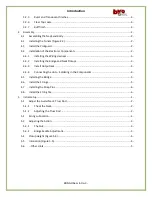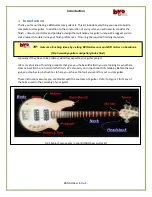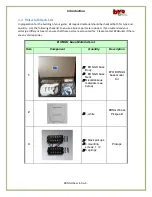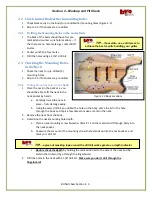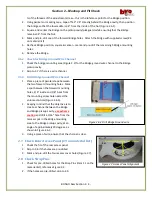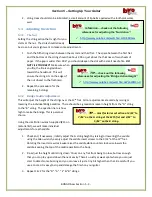
Section 3
– Finishing Your Guitar
BONGO bass Section 3- 3 -
3.
Use a flexible sanding block with #150 grit aluminum-oxide sanding paper to sand the guitar
body until there is a consistent scratch pattern on the entire surface. Note: DO NOT round over
the neck pocket or the body cavities. When hand sanding, always sand in the same direction as
the wood grain.
4.
Re-sand the entire guitar body and neck with #220 grit sanding paper and lightly round over the
outside edges of the body.
5.
Wipe the guitar body and neck with a damp cloth to “raise" the wood grain.
6.
Wait until the wood is dry and re-sand with #220 grit sandpaper to sand the “raised" grain
smooth.
(Note: On a maple fingerboard you can apply a clear finish to the entire neck and fingerboard. Apply
several coats and remove buildup on the frets between coats. An easy way to remove the finish buildup
on the frets is to take a nail and file a half round slot in the head about the same size as the frets. You
can then use this to easily scrape any finish build up.
If the neck has a Rosewood or Ebony fingerboard, be sure to tape off the fingerboard before applying
the finish. Behlen’s Fingerboard Oil is a great product for your fingerboard.)
3.2.2
Appling Grain Filler
Grain filler will fill in the grain and create flat surface. This is essential if you are trying to get a high gloss
finish. Oil based grain filler is recommended. We recommend using Behlen PORE-O-PAC grain filler. For
most finishes use natural colored filler. The dyes used in darker fillers may over time find their way
through the color coat.
Apply the filler by wiping across the grain. You can use a course cloth or your fingers to wipe the grain in.
After it has dried about ten to twenty minutes the excess can be removed with a cloth dampened with
mineral sprits. After about an hour repeat the process and let dry overnight. If you have removed most
of the excess with mineral spirits the remaining filler on the field of the wood can be sanded off (use
#220 again) in a few minutes. It is also a good idea at this time to reopen any of the screw holes in the
body. Use a toothpick or small drill held between your fingers to clean out any filler in the holes. The
body is now ready for a sand and sealer coating.
3.2.3
Applying Sanding Sealer
Sand and sealer is used to give the final coat a level base. It is also helpful in filling scratches which are
too deep to sand out. We recommend using Behlen Vinyl Sealer. This comes in aerosol cans and can
easily be sprayed on.
3.2.4
Solid Color Primer
The last step before applying the color coats is to apply a white primer coat. We recommend using Ohio
Valley Nitro Primer. The white background will also let you apply an opaque color coat with less paint.
Spray on two coats. When dry you may notice that the surface feels rough. Sand off the roughness with
#320 dry and respray. Sand again. If the surface now appears smooth and all grain is opaqued you are
ready for the color coat.

